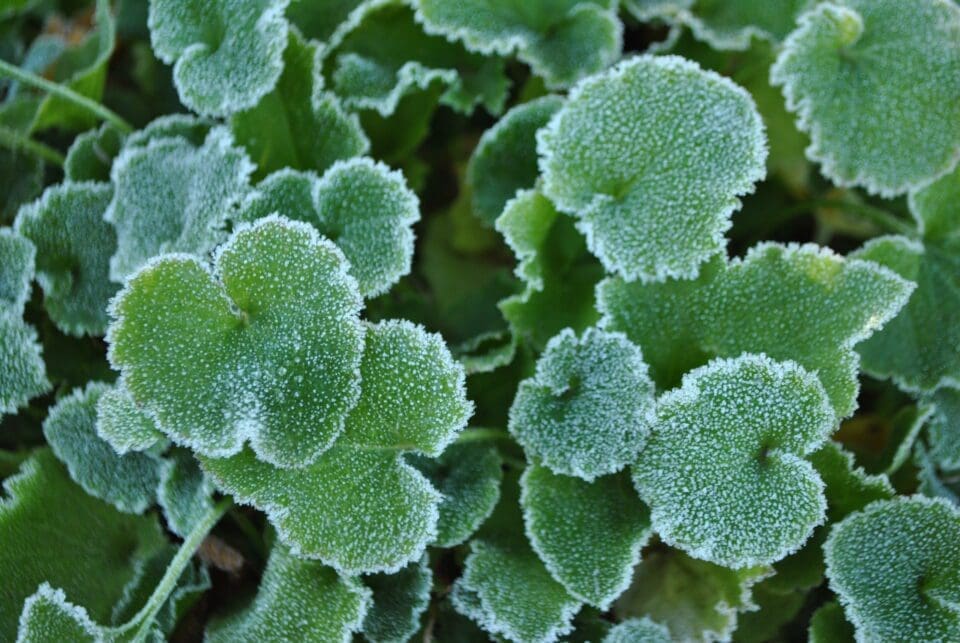Climate change is causing extremes of weather, and none is more deadly to your garden than the silent killer of frost. Gardeners are being urged to prepare for frost throughout winter and early spring by horticultural charity Garden Organic.
In January 2021 a record 18.5 air frost days were recorded in the UK.
When temperatures are low, frost will form. It can look beautiful, but it can be a silent killer of your plants. The water contained in plant stems expands when it freezes, which can cause their cell walls to break. This stops nutrients being transported within the plant, which in turn causes it to wither and die.

Some hardy, resilient plants such as evergreen bushes and trees cope well with frost, although their leaves and flowers may not. Other plants survive because they are dormant, or their cells don’t freeze. But even hardy plants can suffer with long cold spells. Frozen soil means that their roots cannot absorb water and this can cause the plants to die due to lack of moisture.
The vast majority of annuals and vegetables are unable to survive frost and if you plant out your annuals too early in the year frost can attack them too.
Sarah Brown, presenter of the Organic Gardening Podcast from Garden Organic, answers some of the most frequently asked questions about frost.
How do I protect my plants from frost?
Try to choose plants which are labelled as hardy for your part of the country and protect more tender half-hardy species by planting them in sheltered areas, often against a wall or under shrubs and trees.
To protect your tender perennials such as pelargoniums and fuschias move them indoors during the winter and ensure you don’t put them out again until the frost risk has passed.
Don’t cut back old growth on herbaceous perennials in autumn, as it can protect the plant’s central crown.
Some trees such as palms and cordylines should have their leaves gathered into bunches and tied up to protect their crowns. Add an extra layer of protection by tying hessian or bubble wrap, padded with straw, around them.

How can I prepare if I know frosty weather is on the way?
Use a mulch of dead leaves, straw or horticultural fleece in autumn to insulate the soil. This may prevent the ground from freezing (depending on the severity of the frost) but remember to remove it when the air temperatures rise in the spring.
Use a cloche to cover small plants. Or in an emergency a plant pot, upturned bucket or cardboard box will be better than nothing. But don’t forget to remove it later in the day once the frost has gone or your plants will be deprived of light!
Any outdoor pots should be frost proof and will be better placed on feet or bricks to prevent them touching the frosty ground and to protect them from getting waterlogged.
What can I do after a hard frost hits?
A hard frost can cause recently planted plants to lift out of the soil. If this happens ensure you firm them into the ground again so that the roots are under the soil.

How can I help plants recover from a frost?
Plants often get damaged by a late frost in April or May, when they are putting out first shoots. They may recover in time, but you can give them a helping hand by cutting back any damaged growth down to a healthy bud. Feeding them with a liquid feed such as homemade comfrey or nettle ‘tea’ will also help them recover.
If frost persists, then tender plants can be taken up and put under cover – protected by a cold frame or greenhouse. This will help them rejuvenate and grow.
Fruit plants are fairly hardy while dormant, but they can easily be damaged when they start to regrow, and their blossom is particularly vulnerable to late spring frosts. If you know your plot is particularly frost prone, choose late flowering varieties.
Educating gardeners, so they can cope with changing weather conditions is a growing part of Garden Organic’s work, and the number of requests they receive for advice is growing.
Gardening enthusiasts who are interested in receiving regular updates about how to avoid damage in extreme conditions can become a member of Garden Organic. They will be able to access a member’s only area of Garden Organic’s website, which is packed full of hints and tips on how to grow organically and look after your garden throughout the different seasons. They will receive the member’s Organic Way magazine and be able to benefit from members discounts on gardening courses. Visit: gardenorganic.org.uk/join-us
Further information on growing organically can be found by visiting the Garden Organic website at gardenorganic.org.uk/.





